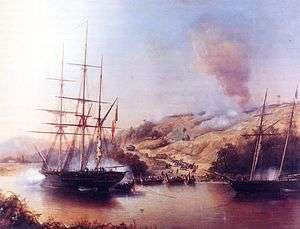Nunez River

Nunez River or Rio Nuñez is a river in Guinea with its source in the Futa Jallon highlands. Lying between the Kogon River to the north and the Pongo River to the south, the Nunez empties into the Atlantic Ocean along the coast of Guinea-Conakry. The river is swollen each year during the rainy season, producing floodplains and inland swamps. These floodplains are inhabited by the Nalu and Baga people. At the mouth of the river is the village of Kanfarandé (formerly Victoria). About 40 miles (64 km) inland is the city of Boké; the largest on the river and the chief commercial center of Guinea. Here the river is 100m wide and 1m deep.[1][2]
Prior to 1840, this river served as a market for Fulbe slave caravans transporting slaves from the Muslim Imamate of Futa Jallon.[3] During the 1870s, this river was a major export point for peanuts, with 5,000 tons per year. In the 1880s, the trade turned to rubber.[4]
References
- ↑ Fields-Black, Edda L. (2008). Deep roots: rice farmers in West Africa and the African diaspora. Blacks in the diaspora. Indiana University Press. p. 32–34. ISBN 0-253-35219-3.
- ↑ National Geospatial-intelligence Agency (2005). Prostar Sailing Directions 2005 West Coast of Europe & Northwest Africa Enroute (9th ed.). ProStar Publications. p. 239. ISBN 1-57785-660-0.
- ↑ Thomas, Hugh (1997). The slave trade: the story of the Atlantic slave trade, 1440-1870. A Touchstone Book. Simon and Schuster. p. 683. ISBN 0-684-83565-7.
- ↑ Martin A. Klein (1998). Slavery and colonial rule in French West Africa. African studies series. 94. Cambridge University Press. p. 145. ISBN 0-521-59678-5.
Coordinates: 10°35′40″N 14°40′30″W / 10.5945°N 14.6751°W